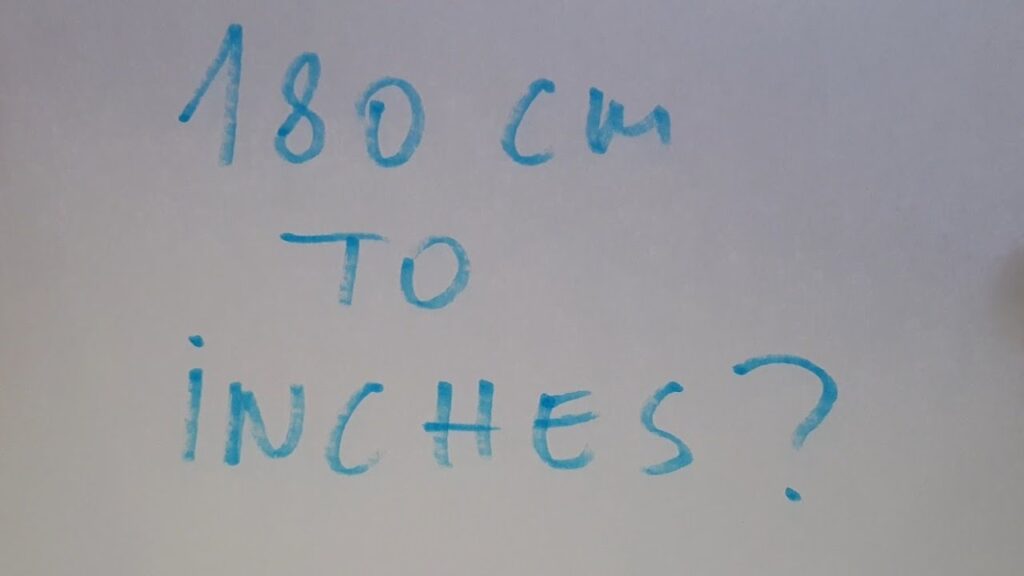How Many Inches is 180 cm? A Comprehensive Guide
Understanding measurements is crucial in various fields, including science, engineering, and everyday life. One common conversion is from centimeters (cm) to inches. This article will explore the conversion of 180 centimeters to inches, the significance of these measurements, and practical applications in different contexts. We will also provide a detailed FAQ section and additional resources for further understanding.
Understanding the Metric and Imperial Systems
Before diving into the conversion, it is essential to understand the two measurement systems involved: the metric system and the imperial system.
The Metric System
The metric system is a decimal-based system of measurement used worldwide. It includes units such as meters, liters, and grams. The metric system is based on powers of ten, making it straightforward to convert between units.
- Common Metric Units:
- Length: millimeters (mm), centimeters (cm), meters (m)
- Volume: milliliters (ml), liters (L)
- Mass: grams (g), kilograms (kg)
The Imperial System
The imperial system, also known as the customary system, is primarily used in the United States and a few other countries. It includes units such as inches, feet, and pounds.
- Common Imperial Units:
- Length: inches (in), feet (ft), yards (yd)
- Volume: fluid ounces (fl oz), pints (pt), gallons (gal)
- Mass: ounces (oz), pounds (lb)
Conversion from Centimeters to Inches
To convert centimeters to inches, you can use the following conversion factor:1 inch = 2.54 centimetersTo convert from centimeters to inches, you can use the formula:
Calculating 180 cm in Inches
Using the conversion formula, we can convert 180 centimeters to inches:
Thus, 180 centimeters is approximately 70.87 inches when rounded to two decimal places.
Practical Applications of Centimeters and Inches
Understanding the conversion between centimeters and inches is essential in various fields:
- Construction and Carpentry: Many building plans and specifications may use different measurement systems. Accurate conversions ensure that materials fit correctly.
- Fashion and Clothing: Clothing sizes may be listed in either centimeters or inches, making conversions necessary for accurate fitting.
- Health and Fitness: Height and weight measurements may be recorded in different units, requiring conversions for proper assessments.
- Travel and Navigation: Maps and GPS systems may use different measurement systems, making it essential to understand conversions for accurate navigation.
Summary Table of Common Conversions
Here’s a table summarizing common centimeter to inch conversions for quick reference:
| Centimeters (cm) | Inches (in) |
|---|---|
| 1 cm | 0.3937 in |
| 5 cm | 1.9685 in |
| 10 cm | 3.937 in |
| 20 cm | 7.874 in |
| 50 cm | 19.685 in |
| 100 cm | 39.370 in |
| 180 cm | 70.866 in |
Importance of Accurate Measurements
Accurate measurements are vital for achieving desired results in any project. Whether you are constructing a building, designing a product, or creating art, understanding the correct dimensions ensures that everything fits together as intended.
Tools for Measurement Conversion
To facilitate conversions between centimeters and inches, several tools can be helpful:
- Online Conversion Calculators: Websites and apps that allow you to input a value in one unit and receive the equivalent value in another unit.
- Measurement Conversion Charts: Printed charts that provide quick reference for common conversions.
- Smartphone Apps: Many apps are available that can perform unit conversions quickly and easily.
Conclusion
In summary, 180 centimeters is approximately 70.87 inches. Understanding how to convert between these two measurement systems is essential in various fields, from construction to fashion. By using the conversion formula and tools available, you can easily navigate between centimeters and inches, ensuring accuracy in your measurements.
FAQ Section
Q1: How do I convert centimeters to inches?
A1: To convert centimeters to inches, divide the number of centimeters by 2.54. For example, 180 cm is approximately 70.87 inches.
Q2: Why is it important to understand both metric and imperial systems?
A2: Understanding both systems is crucial for professionals working in international contexts, ensuring compatibility and accuracy in designs and specifications.
Q3: Are there any tools available for converting measurements?
A3: Yes, there are numerous online calculators and conversion tools available that can quickly convert between metric and imperial units.
Q4: Can I use a ruler to measure in both centimeters and inches?
A4: Yes, many rulers have both metric and imperial markings, allowing for easy measurement in either system.
Q5: What is the significance of accurate measurements in daily life?
A5: Accurate measurements are essential for various activities, including cooking, construction, and health assessments, ensuring desired outcomes and safety.For more detailed information on measurement systems and conversions, you can refer to the Wikipedia page on Units of Measurement.



